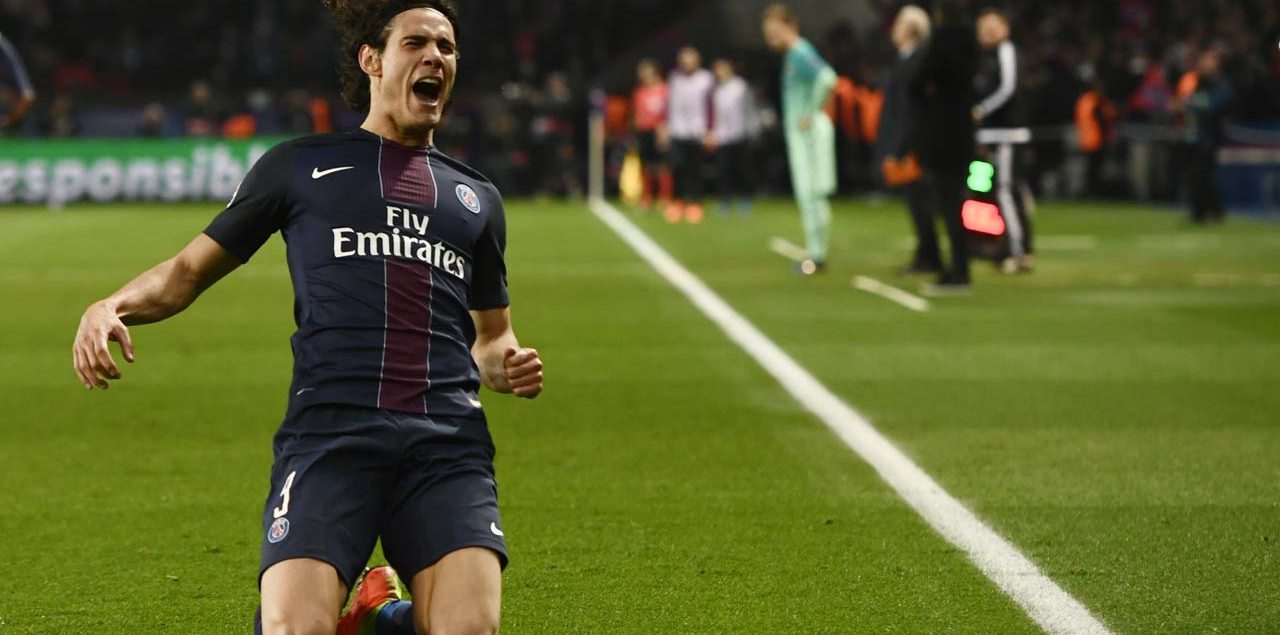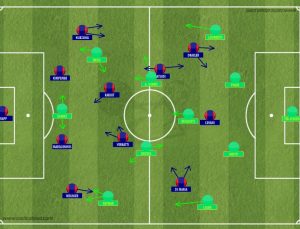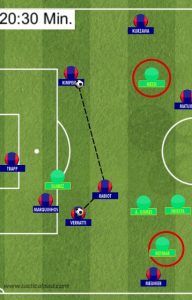Tactical Analysis: Paris Saint-Germain vs. Barcelona (H)
Throughout the 2016/17 footballing season, there were many interesting matches. Many of these go relatively unnoticed in the chaos of the schedule and are neglected in terms of the depth they deserve. In a Breaking The Lines exclusive feature, writer Ross Eaton (@boxtoboxcb) will be analysing a series of these intriguing football matches…
Meeting once again in the UEFA Champions League was Barcelona with what now appears to be France’s ‘biggest club’: PSG. At the Stade de France this year however, the battle between the Frenchman and the Catalans came amidst more challenging than atypical domestic campaigns for both sides. Monaco and Real Madrid, both also remaining in the Champions League, may prove to be opponents both domestically and in Europe for whoever may progress. This first leg tie in Paris was sure to be imperative to the outcome of the fixture.
From a shape which varied between a 4-2-3-1 and 4-3-3, PSG started with far more homegrown players than their typically big-spending approach complies with. Kevin Trapp was the GK. A relatively young back-four was made up of Meunier, Marquinhos, Kimpembe and Kurzawa. Marco Verratti and Adrien Rabiot played in a double-pivot. Blaine Matuidi, based slightly to the left, played in a hybrid midfield role with an average position slightly ahead of the deep pairing. Di Maria and Draxler played as the two wide based attackers, with Edinson Cavani the team’s number 9.
Barcelona used their typical 4-3-3. Fellow German GK Marc Andre ter-Stegen played behind Sergi Roberto, Pique, Umtiti and Jordi Alba. Busquets was the single-pivot. To his right and left was Andre Gomes and Iniesta. Messi played from a relatively wide role on the right, with Suarez and Neymar the 9 and LW respectively.
Double-Pivot and the Nulification of Messi
As the base of PSG’s midfield was a young double-pivot of Adrien Rabiot and Marco Verratti. The pair had key roles for PSG in all phases, usually holding positions slightly in front of the back four, centrally.
One reason for the deployment of two defensive midfielders in this match was to combat the inverted movements of Lionel Messi, into and from the right halfspace. A pivotal part of the Argentinian magician’s game is to make skillfull dribbles from the right, through the halfspace into dangerous central spaces. Just one metre of space is enough for him to accelerate into and exploit a whole defensive block. By deploying two pivots, the near player to Messi when in possession, usually Rabiot, could make horizontal shifts to close any space in the right halfspace and engage him with pressure. This stopped him being able to dribble freely into the right halfspace. Rather than a single pivot making this defensive action, there was now a second pivot to shift horizontally too, to cover the centre whilst his partner defended slightly wider. This scheme was successful as we saw Messi play in an extremely wide role by his norm in what could be considered the Argentinian’s worst performance in many seasons.
Again looking at the role’s of the pivots defensively, the compactness of PSG on both axis allowed for more flexible and situational positioning from Rabiot and Verratti. Pressing diagonally and with great compactness on Pique, Busquets and Umtiti, Barcelona were frequently forced into building on the wings. With Barca’s central-orientation in progression lessening, Rabiot and Verratti were able to positions themselves slightly wider and give more support to their full-backs in wider defending.
In the first phases of build-up, the stability the double-pivot provided was fundamental to the rest of PSG’s possession game. From positions close to the backline, but a few metres in front, Rabiot and Verratti’s roles both had the flexibility to allow either of them to play between the attacking midfield spaces and deep midfield positions, or even drop into the backline.
This allowed for strong occupation of the centre and inner halfspaces at different heights. This flexibility provided opportunity for the needle and line-breaking abilities of Verratti and the strong dribbling and progressional movements of Rabiot in whatever position they were needed situationally.
Against Barcelona, whose front three pressed with intensity, quite often backed up by a flat (Busquets moved up alongside Gomes and Iniesta) three behind them, it was clear that PSG would require a clean stable build-up to evade the pressing. By having the flexibility in their roles to drop into the backline, there was less risk of Barcelona’s press having an overload on an under occupied PSG backline.
Switching Sides
Facing the, frequently disjointed, press of Barcelona’s front three, PSG attempted a few different solutions in exploiting the press and accessing key build-up spaces.
With Marquinhos and Kimpembe usually position rather wide in either halfspace, with either of the pivots having the flexibility in their positioning to occupy the central space left in the backline, an efficient structure was established in stretching the press, forcing a wider distance to be covered due to a range of zones being occupied and connected with. The backline provided stability whilst full-backs Meunier and Kurzawa pushed up to occupy higher positions on the wing, usually in line with the second pivot. By having the full-backs in higher positions and the centre-backs pushing out wider, Messi and Neymar were caught in two minds, and forced to adopt the responsibility of defending both the full-back and centre-back, and the spade in between. With Messi and Neymar often being pinned out wide, Suarez had a very large, and unrealistic distance to cover in the three central zones, to press by himself. Due to having large spaces deep and centrally wherever Suarez wasn’t currently pressing, PSG’s backline could make small horizontal/vertical movements to open lanes and angles around him, making quick combinations to access the spaces in the backline.
Exploiting the isolated Suarez’s pressing to find the free CB was very effective for PSG. The receiving CB often had great space to dribble into a deep midfield position, where Di Maria/Draxler would drop deep into the halfspace to receive horizontally to Busquets. Alternatively, there would be an overload with CB/FB against the single Barcelona winger, this allowed the PSG full-back to either receive the pass in space on the wing if the CB drew a press from the winger, or the full-back could pin the winger and open space for the centre-back on the ball.
Conclusion
In what was a crazy match between PSG and Barcelona in terms of pre-game expectations being shattered, the French champions destroyed Barca with an obliterating performance in all phases and almost all aspects. Not only this, but the Catalonian side undone themselves in a number of aspects of the match. The simplicity in which PSG were allowed to progress, especially centrally, was very weak and worrying, considering their lack of solutions. Most significantly in the match perhaps, was PSG’s closing down of Lionel Messi, who some labelled his performance as the worst the Argentinian has ever played. The double-pivot of Verratti-Rabiot excelled in this capacity, as well as their effective use of possession, which ultimately aided PSG in their thrilling performance.
Whilst Messi and Neymar are pinned wide, PSG combine to escape the isolated presser Suarez and access the space on the far side.
By: @BoxToBoxCB
Photo Credit: CHRISTOPHE SIMON / AFP



